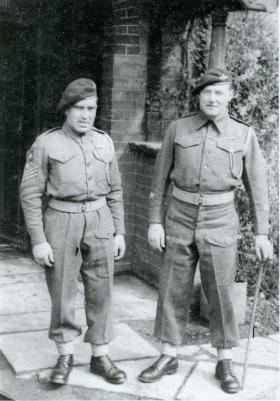William Scott enlisted into The East Yorkshire Regiment on 21 February 1933. [1]
By 1941 he had risen to the rank of Warrant Officer Class II.
He volunteered for Airborne Forces and initially joined the 4th Parachute Battalion at Kedleston, near Nottingham, on 1 January 1942, but on 8 January he was attached ‘for all purposes’ to the 3rd Parachute Battalion. [2]
He then went to RAF Ringway to attend Preliminary Parachute Course No 7, in January 1942, where he carried out the two balloon and five Whitley aircraft descents to qualify as an Army Parachutist. [3]
He saw active service in North Africa and Italy in 1943.
It is not known when he was posted to the 2nd Parachute Battalion, but by 1944 he was the Company Sergeant Major of ‘B’ Company, and was billeted at Colsterworth in Lincolnshire.
On Sunday, 17 September 1944, he boarded a C47 Dakota aircraft of 32 Squadron, 314th Troop Carrier Group, U.S.A.A.F. at Saltby aerodrome, bound for D.Z. ‘X’ near Renkum in Holland as part of Operation ‘Market-Garden’. He dropped successfully, although not in great comfort, Pte. Arthur Bacon, the ‘B’ Company Clerk: “CSM Scott and myself were drunk the night before we dropped. A few previous operations had been cancelled and Scott thought that this one would be cancelled as well. His face in the morning when we heard that the drop was on, was a picture!” [4]
He made it through to the Arnhem Road Bridge area and fought there for the next four days. On the evening of the second day, 18 September, Captain Hoyer-Millar was given the task of organising and leading a patrol: “I recall that evening quite clearly. Major Crawley had made it quite clear that our main task on the bridge was to report back any enemy movement indicating that they were trying to cross from south to north under cover of darkness. Taking prisoners was a secondary, though clearly defined task. I took about twelve men out and moved towards the bridge itself. It was a large expanse of open area and it was quite dark. Our party was a mixed group of men from B-Company, but mainly from 4th Platoon. Names that have been mentioned as taking part are: CSM Scott, my batman Paddy Logan (I think), Sergeant Carrier, Corporal Wood and Corporal Chilton and Privates Smith, Cartledge, Stott, Moon, Cole, Barrett and Izzard.” [4]
By the evening of 20 September and early morning 21 September, the remnants of the 2nd Parachute battalion were surrounded in a few houses and a garden on the North-west side of the Bridge ramp. On the morning of Thursday, 21 September the order was given to split up into small parties and try and escape back to the main part of the 1st Airborne Division. Pte. Norman Dellar, 4 Platoon, B-Company: “CSM Scott, Private Cole and myself were together at the end of the battle and tried to move away from our last position. We were in the garden we had been in during the day and we had to cross a road if we wanted to get out of there. On the other side of the street was a wall with a hole in it and CSM Scott told me to go first. I dashed across and went through the hole in the wall. I immediately fell into a slit trench that was dug there and was dazed for a few seconds. I then heard a man moaning nearby and I looked up. There was a man in the slit trench who had one eye hanging out of its socket. I pushed the eye back and then realised that Scott and Cole had not followed me. I have no idea where they went to or what had happened but it turned out later that they were both killed some time after that particular incident.” [4]
CSM William Scott is officially listed as killed in action between 21 and 25 September 1944, and his temporary field grave was found near the area of Arnhem Bridge, after the war.
The son of Ward and Amy Scott; husband of Ruby Joan Scott, of Honicknowle, Plymouth, he was 29 years old, when he was killed.
He is now buried in the Arnhem/Oosterbeek War Cemetery, 20 C 14.
NOTES:
[1] The Parachute Regiment, transfer & Enlistment Book, 05, page 31.
[2] 4th Parachute Battalion. War Diary. January 1942. Appx C.
[3] Parachute Course Report. RAF Ringway. January 1942.
[4] ‘B-Company Arrived’, by David G. Van Buggenham. 2003.
Profile photo supplied by Harvey Grenville
Read More

Latest Comments
There are currently no comments for this content.
Add Comment
In order to add comments you must be registered with ParaData.
If you are currently a ParaData member please login.
If you are not currently a ParaData member but wish to get involved please register.